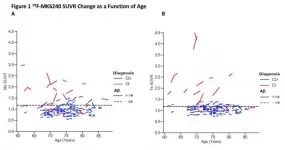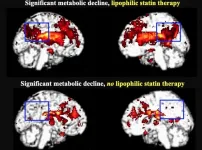(Press-News.org) Reston, VA (Embargoed until 7:30 p.m. EDT, Monday, June 14, 2021)--A novel positron emission tomography (PET) radiotracer has been shown to effectively measure increases in brain tau--a distinguishing characteristic of Alzheimer's disease--before any symptoms of the disease are observed. With the potential to measure increases in tau over a long period of time, this tracer offers an important tool to assess the effectiveness of Alzheimer's disease treatments in clinical trials. This research was presented at the Society of Nuclear Medicine and Molecular Imaging 2021 Annual Meeting.
Tau is a protein commonly found in healthy brain neurons. In people with certain brain disorders, like Alzheimer's disease, chemical changes cause tau proteins to accumulate in various parts of the brain. As such, tau is valuable as a biomarker for measuring disease progression.
In the study, researchers sought to detect patterns and rates of tau accumulation in both a cognitively normal aging population and in those with Alzheimer's disease. PET imaging with the novel radiotracer 18F-MK6240 was performed on all participants at baseline and after 12 months. After each scan, uptake of the radiotracer was measured in multiple areas of the brain.
Increases in tau were measured in both participant groups and longitudinal tau imaging was effective in discriminating between the two cohorts. The uptake of 18F-MK6240 was higher at baseline and after one year in participants who were on the Alzheimer's disease continuum in comparison to the cognitively normal aging participants.
"The effectiveness of the 18F-MK6240 tracer is important for drug trials that aim to measure whether or not treatments to remove tau from the brain are actually working," said Christopher Rowe, BMBS, FRACP, MD, FAANMS, director of molecular imaging research at Austin Health and director of the Australian Dementia Network in Melbourne, Australia. "Use of the radiotracer will allow researchers to select people at different stages of Alzheimer's disease for clinical trials, which ultimately may speed the development of effective treatments for the disease."
Abstract 105. "18F-MK6240 longitudinal tau PET in ageing and Alzheimer's disease," Natasha Krishnadas, Florey Department of Neurosciences & Mental Health, The University of Melbourne, Parkville, Victoria, Australia, and Department of Molecular Imaging & Therapy, Austin Hospital, Heidelberg, Victoria, Australia; Vincent Dore, CSIRO Biomedical Imaging Health & Biosecurity Flagship, Parkville, Victoria, Australia, and Department of Molecular Imaging & Therapy, Austin Hospital, Heidelberg, Victoria, Australia; Rachel Mulligan, Regan Tyrrell, Svetlana Bozinovski, Kun Huang, Fiona Lamb and Victor Villemagne, Department of Molecular Imaging & Therapy, Austin Hospital, Heidelberg, Victoria, Australia; Samantha Burnham, CSIRO Biomedical Imaging Health & Biosecurity Flagship, Parkville, Victoria, Australia; and Christopher Rowe, Department of Molecular Imaging & Therapy, Austin Hospital, Heidelberg, Victoria, Australia, Australian Dementia Network (ADNeT), Victoria, Australia, and Florey Department of Neurosciences & Mental Health, The University of Melbourne, Parkville, Victoria, Australia.
INFORMATION:
All 2021 SNMMI Annual Meeting abstracts can be found online at https://jnm.snmjournals.org/content/62/supplement_1.
About the Society of Nuclear Medicine and Molecular Imaging
The Society of Nuclear Medicine and Molecular Imaging (SNMMI) is an international scientific and medical organization dedicated to advancing nuclear medicine and molecular imaging, vital elements of precision medicine that allow diagnosis and treatment to be tailored to individual patients in order to achieve the best possible outcomes.
SNMMI's members set the standard for molecular imaging and nuclear medicine practice by creating guidelines, sharing information through journals and meetings and leading advocacy on key issues that affect molecular imaging and therapy research and practice. For more information, visit http://www.snmmi.org.
Reston, VA (Embargoed until 7:30 p.m. EDT, Monday, June 14, 2021)--In patients with mild cognitive impairment, taking lipophilic statins more than doubles their risk of developing dementia compared to those who do not take statins. According to research presented at the Society of Nuclear Medicine and Molecular Imaging 2021 Annual Meeting, positron emission tomography (PET) scans of lipophilic statin users revealed a highly significant decline in metabolism in the area of the brain that is first impacted by Alzheimer's disease.
Statins are medications used to lower cholesterol and reduce the risk of heart attack or stroke. They are the most commonly used drugs in the developed world, and nearly 50 percent of Americans over age 75 use a statin. Different types ...
The use of 'ice' flavoured e-cigarettes may be common and positively associated with conventional smoking and nicotine dependence among young adults, suggests research published online in the journal Tobacco Control.
And it's unclear where these' hybrid' vapes, combining fruit/sweet and cooling flavours, fit into current or future regulatory frameworks, which apply restrictions according to distinct flavour categories, point out the study authors.
'Ice' flavoured e-cigarettes--marketed as a combination of fruity/sweet and cooling flavours, such as 'blueberry ice' or 'melon ice'--recently entered the US market. Previous research ...
Below please find summaries of new articles that will be published in the next issue of Annals of Internal Medicine. The summaries are not intended to substitute for the full articles as a source of information. This information is under strict embargo and by taking it into possession, media representatives are committing to the terms of the embargo not only on their own behalf, but also on behalf of the organization they represent.
1. A third dose of COVID-19 vaccine increased antibody levels in organ transplant recipients with a suboptimal response following standard 2-dose vaccination
Study is the first to report on response to a third vaccine ...
KINGSTON, R.I. - June 14, 2021 - The rarest frog in Rhode Island may not be as rare as scientists once thought after a study by University of Rhode Island researchers using a seldom-used methodology turned up many more of the endangered animals than they expected.
Eastern spadefoots - often called spadefoot toads, though they are actually frogs - have long been considered highly secretive and difficult to find outside of their one- or two-day annual breeding periods on rainy nights. In some years, they don't breed at all. But after scientists reported just 50 sightings of the frogs over the previous 70 years, the Rhode Island researchers observed 42 spadefoots ...
WASHINGTON -- Researchers have developed a way to dynamically switch the surface of liquid
metal between reflective and scattering states. This technology could one day be used to create electrically controllable mirrors or illumination devices.
Liquid metals combine the electrical, thermal and optical properties of metals with the fluidity of a liquid. The new approach uses an electrically driven chemical reaction to create switchable reflective surfaces on a liquid metal. No optical coatings nor polishing steps, which are typically required to make reflective optical components, are necessary to make the liquid metal highly ...
COLUMBIA, Mo. -- While the United States faces a nationwide nursing shortage, a recent study at the University of Missouri found rural Missouri counties experience nursing shortages at a greater rate than the state's metropolitan counties. In addition, the study found rural Missouri counties have a higher percentage of older nurses nearing retirement, which could have a severe impact on the future of the state's nursing workforce.
Anne Heyen, an assistant teaching professor in the MU Sinclair School of Nursing, analyzed workforce data of nearly 136,000 licensed Missouri nurses to identify the age and geographical disparities ...
DARIEN, IL - More veterans are receiving important sleep care, especially those living in rural areas where access to sleep medicine specialists can be difficult. The Veterans Health Administration's TeleSleep Program launched telehealth services in 2017 to support the testing, diagnosis, and treatment of obstructive sleep apnea and other sleep disorders. More than one million veterans who received care from VHA in 2020 have sleep apnea.
"The implementation of these services has been very successful," said Dr. Kathleen Sarmiento, program lead for the Office of Rural Health TeleSleep ...
Red seaweeds have been prevalent in the diets of Asian communities for thousands of years. In a new study, published in Marine Drugs, researchers have shown how these algae confer health benefits.
"In the past, people have wondered why the number of colon cancer patients in Japan is the lowest in the world," said Yong-Su Jin (CABBI/BSD/MME), a professor of food microbiology. "Many assumed that it was due to some aspect of the Japanese diet or lifestyle. We wanted to ask whether their seaweed diet was connected to the lower frequency of colon cancer."
Although several studies have shown that Asians who eat seaweed regularly have lower risk of colon, ...
Methane is a strong greenhouse gas that plays a key role in Earth's climate. Anytime we use natural gas, whether we light up our kitchen stove or barbeque, we are using methane.
Only three sources on Earth produce methane naturally: volcanoes, subsurface water-rock interactions, and microbes. Between these three sources, most is generated by microbes, which have deposited hundreds of gigatons of methane into the deep seafloor. At seafloor methane seeps, it percolates upwards toward the open ocean, and microbial communities consume the majority of this methane before it reaches the atmosphere. Over the years, researchers are finding more and more methane beneath the seafloor, yet very little ever leaves the oceans and gets into the atmosphere. Where ...
HOUSTON - (June 14, 2021) - In the two decades since the Human Genome Project mapped the entire human genome, improvements in technology have helped in developing updated reference genomes used for sequencing. But while the GRCh38 (hg38) human reference genome was released more than seven years ago, the older GRCh37 (hg19) reference remains widely used by most research and clinical laboratories. In a new study published in the American Journal of Human Genetics, researchers at the Human Genome Sequencing Center at Baylor College of Medicine identify ...






